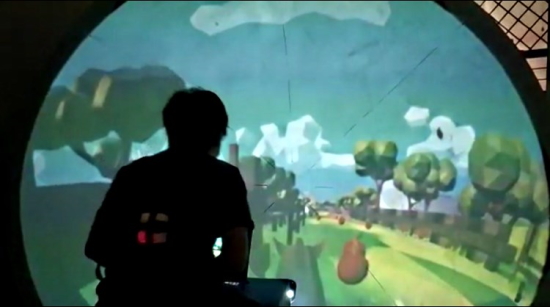[This story from Horsetalk describes an unusual application of presence-evoking technology to provide hippotherapy, which the American Hippotherapy Association
says “refers to how occupational therapy, physical therapy and speech-language pathology professionals use evidence-based practice and clinical reasoning in the purposeful manipulation of equine movement as a therapy tool to engage sensory, neuromotor and cognitive systems to promote functional outcomes.” A quick web search indicates that there are already many types of horse-riding simulators (e.g., from Navi-IT
), but the one in this story, and the new study in the journal Designs, was created specifically for children with cerebral palsy. See the original story, and the journal article, for more pictures. –Matthew]

Welcome to the iDome: Concept offers virtual-reality riding therapy without a headset
By Neil Clarkson
September 2, 2022
Exercised-based gaming software and a controller have been developed by researchers to help provide a virtual-reality-based experience on a horse-riding simulator.
Its developers believe their engineering concept, which does not employ a virtual-reality headset, could benefit children with cerebral palsy.
The Indonesian study team has described their design, which includes a convex mirror to provide a virtual-reality immersive environment for participants, in the journal Designs.
Ardianto Satriawan and his fellow researchers noted that horse riding exercise, also known as hippotherapy, is a popular treatment for children with cerebral palsy.
However, the need for trained therapists, land, and the costs associated with maintaining horses can make hippotherapy unaffordable, or unavailable, for most patients in Indonesia.
This led the study team to consider mechanical horse-riding simulators to replace actual horse hippotherapy.
“However, most patients are children and are easily bored when asked to do monotonous activities for an extended period,” they said. “The room setting also does not give the patient visual inputs that usually help motivate the children in real-horse hippotherapy activities.”
To solve this problem, they designed an exercise game software called Sirkus Apel, which means Apple Circus, to provide users with a fun exergaming activity while doing the therapy.
They also designed an inertial sensor-based controller that lets the patients control the in-game horse through their back movements, which can benefit patients with cerebral palsy.
The researchers decided against using head-mounted displays, which traditionally provide virtual-reality inputs, for safety reasons.
Head-mounted displays can be hazardous for children, they said, because it obstructs their view of the environment, especially when riding a horse-riding simulator.
“Numerous researchers also report another problem of head-mounted display usage: Motion sickness caused by the inconsistency between the visual input of the eyes and the user movements.”
This, they said, can result in nausea, headache, disorientation, and vomiting, which is dangerous and uncomfortable, especially for children with cerebral palsy.
However, they still wanted to make the visual input enjoyable to the user. To achieve this, they built a convex mirror-based dome to provide a three-dimensional view.
“We then project the game content to the dome to provide an immersive experience to the patients making it as if they are riding a real horse inside the game.”
They based their dome on the design of the iDome by Paul Bourke, reported in a 2009 study.
“The design of iDome is inspired by a planetarium hemisphere shape. The hemisphere is cut in half to place the users in front of the dome, not under it. This setup provides a broad immersive view without any obstruction of projection hardware but keeps the user aware of the surroundings.”
The team integrated their exergaming software, the virtual-reality dome, a horse-riding simulator (made by Jufit Smart Tech in China), and all the necessary equipment to create a whole hippotherapy simulator platform.
The game they developed requires users to avoid obstacles by moving the in-game horse and picking up apples that appear on the ground. It consists of four levels or, more accurately, scenes.
The software animates the horse’s head view, to make the user feel like they are riding an actual horse. The end result can provide children with fun experiences while giving them the therapy benefit to improve their health conditions.
Six healthy adult participants tested the hippotherapy simulator. They reported no signs of motion sickness. They felt relatively safe while testing the device and noted the immersiveness of the iDome.
The authors said they were interested in testing the effectiveness of the hippotherapy simulator device on children with cerebral palsy, especially in terms of their postural control. They have already identified some volunteers to conduct further research in this area.
“Aside from cerebral palsy rehabilitation, hippotherapy has been known to be an effective rehabilitative method for patients with neurological and other disabilities such as stroke victims, autism, head injury, arthritis, multiple sclerosis, spinal cord injury, and many others.
“Each type of rehabilitation may require specific horse movements, which may be provided by mechanical means.”
Potentially interesting future research could center on designing a suitable mechanical horse, which could create movements for all the needed gaits. “We can also design a flexible saddle and footrest to accommodate all the age ranges of the patients.”
The study team said they considered their simulator to be a cost-effective investment. They intended to donate their design to the Dr Hasan Sadikin Hospital in Bandung.
The study team comprised Satriawan, Wildan Trusaji and Muhammad Ogin Hasanuddin, with the Bandung Institute of Technology; and Septia Susanti Rahadini, Mayang Cendikia Selekta and Ellyana Sungkar, with Dr Hasan Sadikin General Hospital.
—
Satriawan, A.; Trusaji, W.; Hasanuddin, M.O.; Rahadini, S.S.; Selekta, M.C.; Sungkar, E. Design of Virtual Reality-Based Hippotherapy Simulator Exergaming Software and Its Controller for Rehabilitation of Children with Cerebral Palsy in Indonesia: An Engineering Concept. Designs 2022, 6, 76. https://doi.org/10.3390/designs6050076
The study, published under a Creative Commons License, can be read here.
|